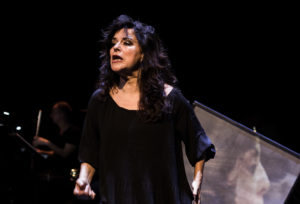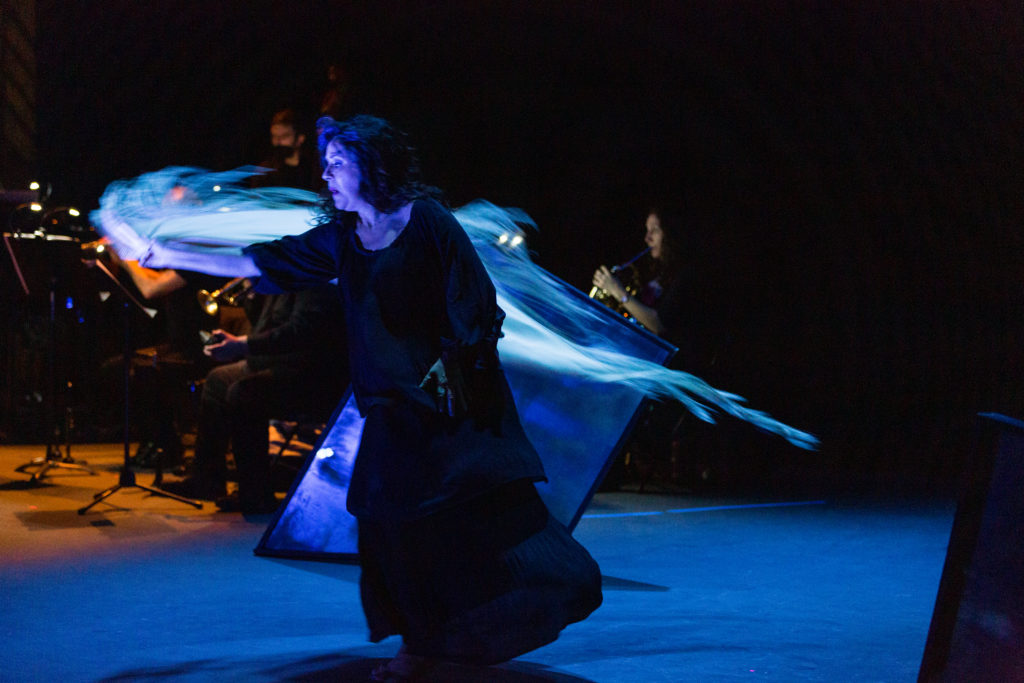
Opera Hispánica & Teatro Grattacielo 2021-22 Review: Cuando el Fuego Abrasa
Nancy Fabiola is Pure Fire in Vibrant Double Bill
By David Salazar(Credit; Gustavo Mirabile)
Opera Hispánica and Teatro Grattacielo opened their respective 2021-22 seasons on Saturday evening with a unique double bill comprising works by Astor Piazzolla and Manuel de Falla jointly called “Cuando el Fuego Abrasa.”
The production, the first collaboration between the two companies, was directed by Malena Dayen and conducted by Jorge Parodi, who led members of the Metamorphosis Chamber Orchestra and soloists mezzo-soprano Nancy Fabiola Herrera, baritone Gustavo Feulien, and bandoneon player Rodolfo Zanetti.
A Rare Combo
On first glance, the double bill, featuring a series of tangos by Piazzolla’s and De Falla’s “El Amor Brujo” seemed like an unlikely pairing. But in this version, the combinations complement one another. The tangos in the set include “Oblivion,” “Canto de noche y llovizna,” “Melancólica Buenos Aires,” “La misma pena,” “Los pájaros perdidos,” “Preludio para el año 3001,” and “Libertango,” and they were structured to create a vocal contrast between Feulien and Herrera alternating as Carmelo and Candela, respectively, almost like dueling and doomed lovers. This provided a set up for “Amor Brujo’s” story. This kind of narrative combination doesn’t always work, even in operas and works that are supposedly related thematically (some productions of “Cavalleria Rusticana” and “Pagliacci” would be better off leaving the two worlds in their own spaces), but it actually works quite well here because of Dayen’s subtle choices.
Obviously, the fact that both works featured the same set, a quartet of slanted mirrors used as projectors throughout, reinforced the connection, but otherwise, we got gentle nods in “Amor Brujo” toward moments in the tangos. Perhaps the most potent was a single gesture – Carmelo grazing his hand gently across Candela’s face. We see this right at the end of “Oblivion” and a very notable callback is projected across one of the four mirrors halfway through “Amor Brujo.” This moment was particularly profound because in “Oblivion,” it was portrayed from the perspective of Carmelo’s character; in “Amor Brujo,” it was clearly Candela’s reminiscence.
But the two contrasting sets complemented each other visually in other ways. The tangos played off as more meditative, each artist limited in his or her movement, the lighting and visual effects more muted (there was some brilliant use of lighting to create shadowy pathways that the actors each walked across in the latter tangos like “Los pájaros perdidos”). Meanwhile “Brujo” was full of fire and energy with Herrera dancing around the stage and projections flying across the mirrors. This stylistic antithesis allowed the works to retain a sense of individuality, but also a firm connection through the juxtaposition. Furthermore, the fractured nature of the tangos furthered the thematic disconnect between the two lovers, while the greater flow of “Brujo” strengthened the focus on Candela’s development.

(Credit: Gustavo Mirabile)
Pure Fire
As Candela, Herrera was pure fire. An international superstar, she has performed at all the major opera houses around the world. She has recorded and performed “Amor Brujo” several times. But she had never performed a staged version of the work, which focuses on Candela seeking out a witch’s cave to bring forth Carmelo and confront him over his abandonment. I’ve seen Herrera a number of times before, particularly at the Met in productions of “Rigoletto” and “Salome” where her robust and potent voice were particular highlights of those performances.
But I had never seen the artistic versatility and brilliance from her on display in Dayen’s production of “Amor Brujo.” What was most eye-opening was her physical interpretation, led by some fantastic choreography by Troy Ogilvie. In one dance she was contorting her body around; in another, she was leading with her hands; in another, it was her shawl. She moved from one side of the stage, from one mirror to the other, her movements in precise synchronization with the lighting effects. We certainly don’t see a lot of the international opera superstars pushing themselves to these limits. But here was Herrera, reminding us that opera singers are so much more than we have come to expect.
Her vocal interpretation was equally engaging. Her approach to the tangos was rather gentle and delicate, even in the rising crescendos of “Los pájaros perdidos.” One could even intuit a frailty in the approach, which lined up with the dramatic situation of Candela losing her love. But when “Amor Brujo” came around, Herrera seemed to find potency, weight, and bloom in her sound; to pull it all off, and grow and grow throughout, in conjunction with the choreography was a testament of her commitment and greatness. This is definitely up there as one of the finest single interpretations I have seen in quite some time.
Feulien’s firm baritone also rounded into top form as the first half wore on, with his finest moments coming in “Preludio para el año 3001;” there was a robustness to his sound, particularly in the high notes. The “Libertango” offered a rather unique challenge for the baritone as he would be asked to switch between rapid poetic recitations and vocal lines. Furthermore, each return of the vocal line pushed the voice up into a higher key, undoubtedly challenging the singer more and more at the very end of his major vocal presentation. But Feulien was up the task, finding more and more vocal potency with every such iteration; even when he clearly forgot some of his text and stumbled through the poetry, he bounced back and delivered the next vocal line with confidence and precision.
Herrera was not the only one transitioning from one type of performance style to another; at the podium, Jorge Parodi was switching between conducting and playing the piano throughout the tangos. His ensemble never missed a beat and throughout this opening set felt cohesive. A lot of the vibrancy from this opening set lay on the shoulders (and fingers) of bandeon player Rodolfo Zanetti, who was undeniably a standout throughout. In many ways his role was as much a soloist as that of Feulien and Herrera throughout the tangos, often in duet with them.
“Amor Brujo” changed up some of the ensemble members and brought in some winds and brass. While the texture was undeniably changed, Parodi’s ensemble displayed the same level of flexibility throughout the De Falla piece as it nimbly transitioned from one number to the next.
In a subsequent conversation following the performance, someone asked how much longer this production would run for. Unfortunately, the response was that this was a one-night event, a rather common circumstance in the world of opera for many mid-sized companies. In reality, productions such as this one need and deserve more time, not only to allow the artists to continue to explore, but also to invite new audiences to experience it. Hopefully, this production will get a chance to travel in the future and engage with those new and unsuspecting audiences. They will walk away with an unforgettable memory.


